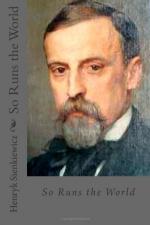“I did not wish to show you that, but it cannot last any longer—the time has come. Give me the genealogical tree of Rougon-Macquart.”
Yes! The genealogical tree of Rougon-Macquart! The reading of it begins: There was one Adelaide Fouque, who married Rougon-Macquart’s friend. Rougon had Eugene Rougon, also Pascal Rougon, also Aristides, also Sidonie, also Martha. Aristides had Maxyme, Clotilde, Victor, and Maxyme had Charles, and so on to the end; but Sidonie had a daughter Angelle, and Martha, who married Mouret, who was from Macquart’s family, had three children, etc.
The night passes, pales, but the reading continues. After Rougons come Macquarts, then the generations of both families. One name follows another. They appear bad, good, indifferent, all classes, from ministers, bankers, great merchants, to simple soldiers or rascals without any professions—finally the doctor stops reading—and looking with his eyes of savant at his niece, asks: “Well, what now?”
And beautiful Clotilde throws herself into his arms, crying: “Vicisti! Vicisti!”
And her God, her church, her flight toward ideals, her spiritual needs disappeared, turned into ashes.
Why? On the ground of what final conclusion? For what good reason? What could there be in the tree that convinced her? How could it produce any other impression than that of tediousness? Why did she not ask the question, which surely must have come to the lips of the reader: “And what then?”—it is unknown! I never noticed that any other author could deduct from such a trifling and insignificant cause such great and immediate consequences. It is as much of an astonishment as if Zola should order Clotilde’s faith and principles to be turned into ashes after the doctor has read to her an almanac, time-table, bill of fare, or catalogue of some museum. The freedom surpasses here all possible limits and becomes absolutely incomprehensible. The reader asks whether the author deceives himself or if he wishes to throw some dust into the eyes of the public? And this climax of the novel is at the same time the downfall of all doctrine. Clotilde ought to have answered as follows:
“Your theory has no connection with my faith in God and the Church. Your heredity is so loose and on the strength of it one can be so much, everything, that it becomes nothing—therefore the consequences which you deduct from it also are based upon nothing. Nana, according to you, is a street-walker, and Angelle is a saint; the priest Mouret is an ascetic, Jacques Lantier a murderer, and all that on account of great-grandmother Adelaide! But I tell you with more real probability, that the good are good because they have my faith, because they believe in responsibility and immortality of the soul, and the bad are bad because they do not believe in anything. How can you prove that the cause of good and bad is in great-grandmother Adelaide Fouque? Perhaps you will tell me that it is so because it is so; but I can tell you that the faith and responsibility were for centuries a stopper for evil, and you cannot deny it, if you wish to be a positivist, because those are material facts. In a word, I have objective proofs where you have your personal views, and if it is so, then leave my faith and throw your fancy into the fire.”




